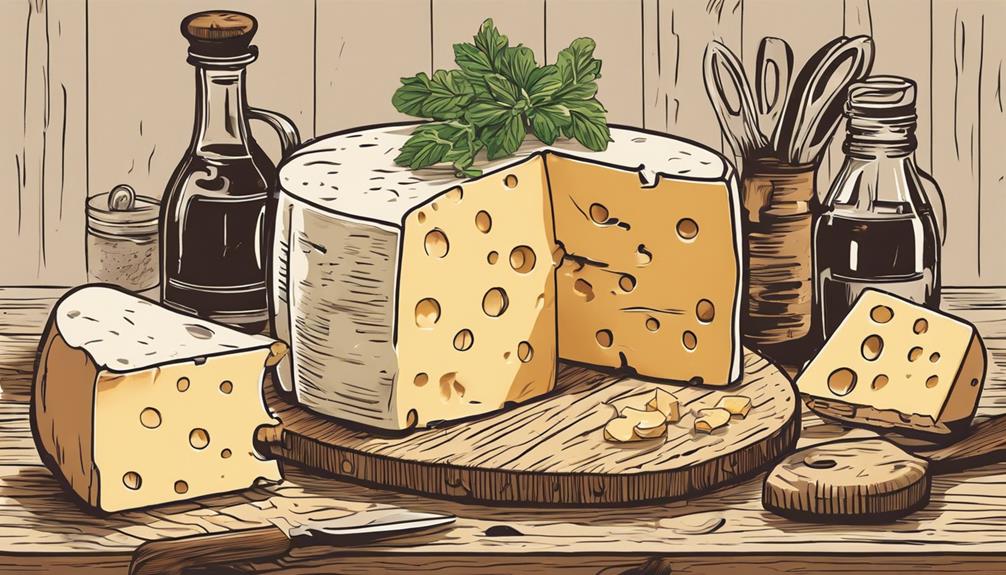How To Become More Self-Sufficient Without Starting a Full-Blown Farm…
Want to start preserving your harvest, making your own soap, or building a backyard root cellar — but not sure where to begin? “Homesteading Advice” gives you instant lifetime access to 35+ practical homesteading books on food preservation, veggie gardening, DIY natural cleaning products (save over $250 per year with this skill alone), brewing, off-grid energy, and a whole lot more…
Click Here To Check It Out Now!
“After recently trying Emmental at a cheese-tasting event, I realized how unique it is compared to other cheeses. I’m considering incorporating it into my recipes at my restaurant, but I need to understand its distinct features better. Can you explain what makes Emmental so special and how I can best use it in my recipes?” Thanks, Mark, Portland, USA.
What Are The Unique Features Of Emmental Cheese?
Hey Mark! I’m thrilled to hear about your interest in Emmental cheese. Emmental, also known as Emmentaler or Emmenthal, is one of the most distinct and beloved cheeses originating from Switzerland. Let’s break down what makes Emmental so special, shall we?
Historical Background
Emmental cheese has a rich history dating back to the 13th century in the Emmental region of Switzerland. This area, located in the canton of Bern, is characterized by lush green landscapes which provide the ideal conditions for dairy farming. The unique methods developed in this region have been passed down through generations, contributing to the rich texture and unique flavor profile of Emmental.
Production Process
The traditional methods of making Emmental cheese involve an intricate process that adds to its unique features:
- Raw Milk: Emmental is typically made from unpasteurized cow’s milk. The quality of the milk is paramount as it directly impacts the flavor and texture of the cheese.
- Curdling and Heating: The milk is heated and combined with a bacteria culture to begin the curdling process. Enzymes called rennet are added to help the milk solids separate from the whey.
- Cutting the Curd: The curds are cut into small pieces and heated again. This process releases more whey and helps to form the distinct texture of the cheese.
- Pressing and Salting: The curds are then pressed into molds and soaked in brine, which gives Emmental its savory taste.
- Aging: The cheese is aged for several months, which is crucial for developing its flavor. During this time, the cheese is stored in a carefully controlled environment to allow the fermentation process to continue.
Distinct Characteristics
There are several unique features that set Emmental apart from other cheeses:
- Eye Formation: One of the most recognizable features of Emmental cheese is its large holes, or “eyes”. These holes are created by gas-producing bacteria, such as Propionibacterium freudenreichii, during the fermentation process. The larger the holes, the higher the quality of the cheese.
- Flavor Profile: Emmental has a mild yet nutty and slightly sweet flavor. As it ages, the sweetness becomes more pronounced, and the cheese develops a more complex taste.
- Texture: The texture of Emmental can range from semi-hard to hard, making it versatile for various culinary uses. The cheese is smooth and creamy, with a slight elasticity thanks to its unique fermentation process.
- Aroma: Emmental has a clean and mildly aromatic scent, which becomes more intense as it ages.
Nutritional Value
Emmental is not only delicious but also packed with nutrients:
- Protein: High in protein, it makes for a nutritious addition to any dish.
- Calcium: This cheese is an excellent source of calcium, essential for bone health.
- Vitamins: It contains vital vitamins such as B12, which is crucial for nerve function and red blood cell production.
- Fat: While high in fat, it contains healthy fats that can be part of a balanced diet.
Culinary Uses
Emmental is incredibly versatile in the kitchen, Mark. Here’s how it shines in various dishes:
- Melting Qualities: Its excellent melting qualities make it perfect for fondue, gratins, and raclette. The cheese melts evenly and offers a creamy consistency.
- Sandwiches and Wraps: Its mild flavor pairs well with a variety of meats, making it a great addition to sandwiches and wraps.
- Baking: Use Emmental in baked dishes such as quiches and tarts for a creamy, nutty flavor.
- Cheese Boards: Due to its unique appearance and delightful flavor, Emmental is a wonderful addition to any cheese board.
- Salads: Shredded Emmental can add a delightful twist to your salads, giving them a richer texture and taste.
Pairing with Drinks
Emmental cheese pairs wonderfully with a variety of beverages:
- Wines: White wines such as Chardonnay or Sauvignon Blanc complement Emmental’s nutty flavors. If you prefer red wine, go for a Pinot Noir.
- Beers: Lagers or light ales can balance Emmental’s mild richness, making for a refreshing combination.
- Spirits: Aged spirits like brandy or whiskey can also create an interesting pairing with Emmental cheese.
Storing Emmental Cheese
Proper storage is essential to maintain the quality and flavor of Emmental cheese:
- Refrigeration: Store Emmental in the refrigerator, preferably in a cheese drawer, to maintain a stable temperature.
- Wrapping: Wrap the cheese in wax or parchment paper, followed by a loose layer of plastic wrap to allow it to breathe while preventing it from drying out.
- Usage: Consume within a couple of weeks for the best flavor, although it can last up to one month if stored properly.
Final Thoughts…
Mark, thank you for reaching out with your question. Emmental cheese truly is a gem in the world of cheeses with its characteristic holes, mild yet nutty flavor, and versatile culinary uses. Understanding these unique features can help you use it to its full potential in your restaurant. Don’t hesitate to experiment with it in various dishes – you’ll likely discover some delightful new favorites!

